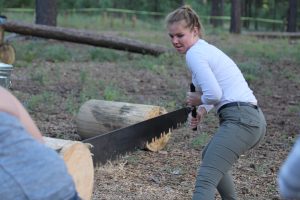- Slug: Sports-NAU logging sports, 758 words
- Photos available
By ERIC NEWMAN
Cronkite News
FLAGSTAFF — Although Northern Arizona University’s students are nicknamed Lumberjacks, it’s the school’s logging sports team that fully encapsulates the meaning of attending college near the Centennial Forest.
The sport is based on the actions of the timber industry of old, chopping wood with saws, axes and chainsaws, while also competing in log-rolling, tree-climbing and a variety of other wood-related activities. About 130 miles north from Phoenix, the campus sits in the trees and provides a perfect location for the only such college team in Arizona.
Competitions consist of approximately 20 individual events that range from speed-chopping, log-rolling, speed-climbing and more in an attempt to gain points and win as an entire team.
For Iliana Castro, the adrenaline rush of sawing through a large log with a crosscut saw is unmatched.
“The feeling when you finally get through it is just really great,” she said. “It hurts your lungs a little, but it’s really fun.”
Castro described an immediate sense of fear holding the same tools that real lumberjacks used, standing on top of a log for balance, swinging sharp axes between one’s legs and using saws with teeth the size of human fingers to sever wood.
Captain Colin Towne remembered watching the Stihl Timbersports Series on ESPN at his grandparents’ house as a kid, and the seed of the tree that was his love for the sport was planted.
“After that moment, I never saw anything like that again until I was going back to college at NAU and I was in the Forestry building, walking around to meet the advisor and I noticed they had some displays out for their logging sports team.”
From there, he was hooked.
The competitors consist mostly of students in NAU’s School of Forestry. Towne is one of many who substantiate their studies by taking the 20-minute dirt-laden path to the forest and actively spending time outdoors.
Freshman Holly Iverson, at her first-ever practice, said that spending her late afternoons in the Centennial Forest seemed all but natural to enhance her understanding of what she was learning in class.
“I think it’s good to be out here in the trees. It’s kind of like a real forestry environment,” she said “Just getting in touch with the original lumberjack stuff. Being out here in Flagstaff specifically enhances the sport tremendously.”
Other veterans, like Castro, take it a step further. A co-captain and nearly three-year veteran of the team, Castro decided to become closer to the sport and her studies, moving out to a log cabin a short walk from the team’s training grounds. Come winter, when temperatures in Flagstaff can reach as low as 10 degrees, the forestry department will force her to move temporarily, she said, but that it is worth it to be closer to the trees and the sport she has learned to love.
“I thought if I moved out here I could practice more, and just be out here more and get better at this, because it’s something I love to do now,” she said.
Beside the ability to spend time in the forest, Castro said one of the biggest thrills of the sport — the risk — is what makes it so unique. She also said with proper safety equipment, such as specific wood-cutting cleats, and detailed training, the sport is much less dangerous than one might initially think.
The team sponsored and placed fourth in the 78th Association of Western Forestry Clubs Conclave in April, a regional competition to reach the national collegiate logging sports championship, in its new facility near campus. A team that at times struggled to keep a consistent number of participants, NAU now typically carries between 10-20 competitors each season.
The challenge, now, Towne said, is to get others interested who are not simply thrown out in the forest with their studies.
His pitch to new students not familiar with logging sports at all is that they are not only a unique competition that naturally strengthens the entire body but one that requires a strong mind as well.
“It’s a lot about technique and precision. You have to be able to hit where you want when you want, as hard as you can,” he said. “A hidden difficulty to the chopping events is reading your wood. As you’re hitting your lines and you’re popping chips out, you have to read how it’s reacting, and you alter where you hit based on that.”
With its new facility, and its best-ever finish at the latest regional conclave, NAU’s real lumberjacks look set for a successful future.
